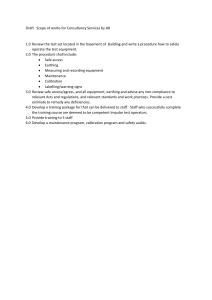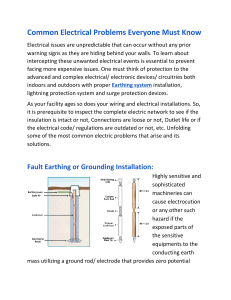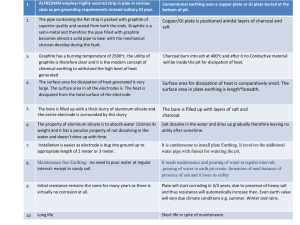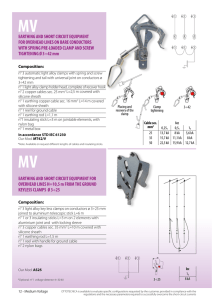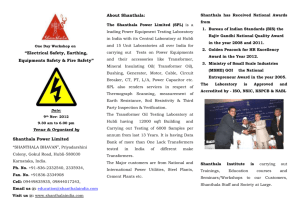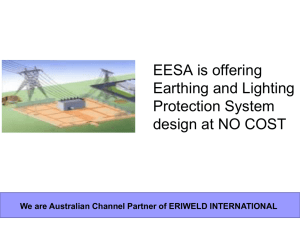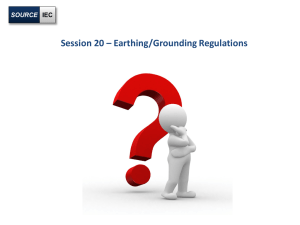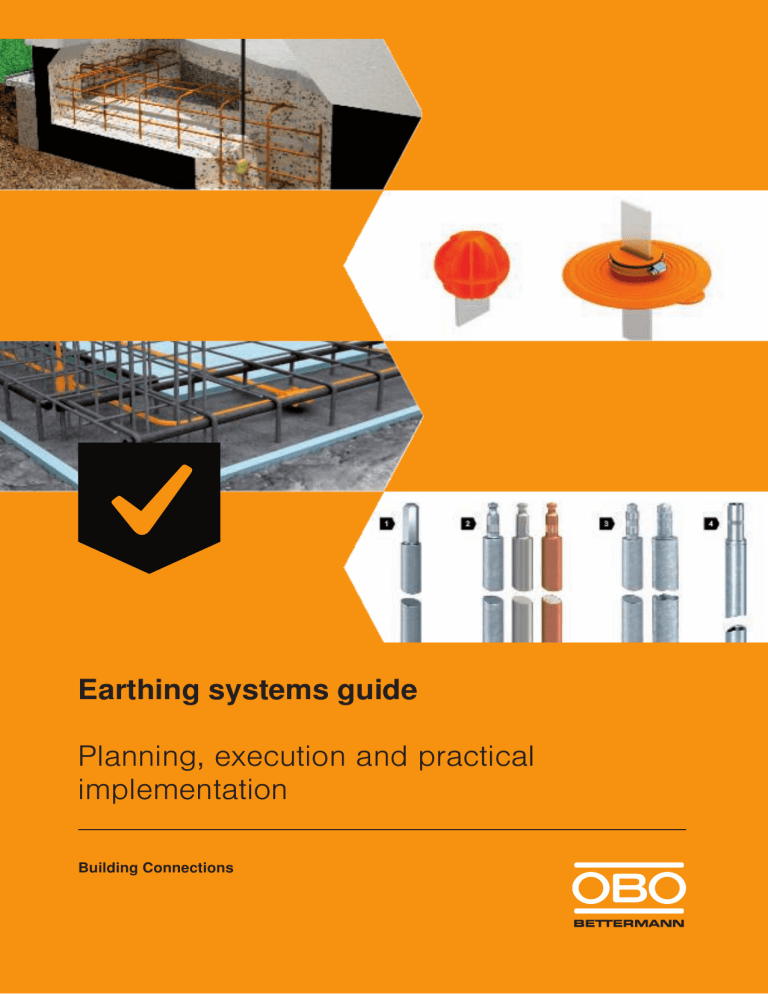
Earthing systems guide Planning, execution and practical implementation Building Connections OBO Construct planning aids Digital selection aids for earthing systems and surge protection The OBO Construct electronic planning aids are programs developed to support electrical installation engineers and planners in the design of electrical installation systems. In particular, in complex areas such as surge protection and earthing, there are countless technical and standard general conditions to be observed. The two OBO Construct programs for earthing and surge protection systems should provide active help here. Systematic questions simplify the search for suitable products and guaranteed surge protection systems and earthing systems which fulfil the standards. OBO Construct for earthing systems The digital selection aid can be used for the easy planning and configuration of earthing systems. The simple and intuitive user guidance leads you through the individual components of the earthing system step by step. The software then automatically calculates the amounts required and the matching accessories. The application can be opened on any end device irrespective of its operating system – be it smartphone, tablet or desktop PC. • Time and place-independent work assistance • Transmit planning requirements to complete product systems • Find suitable products quickly and simply • Calculate material and parts lists automatically • Download configuration results as Excel or Word files 2 TBS Leitfaden Erdungssysteme / en / 2020/04/02 11:50:11 11:50:11 (LLExport_02640) / 2020/04/02 11:50:33 11:50:33 Benefits Contents 1. 2. 3. 3.1 3.2 3.3 3.4 3.5 3.5.1 3.5.2 3.6 3.7 3.8 3.9 3.10 4. 5. 6. TBS Leitfaden Erdungssysteme / en / 2020/04/02 11:50:11 11:50:11 (LLExport_02640) / 2020/04/02 11:50:33 11:50:33 7. Basic principles Normative requirements Earthing systems and their materials Individual foundations Foundation earth electrodes Labelling the connection lugs Insulated earthing systems Lightning protection earthing Earth rod – type A Ring earther – type B Potential control against step voltages Touch voltage Short-circuit current carrying capacity of earthing components (50 Hz) Antenna earthing according to VDE 0855-1 (EN/IEC 60728-11) Earthing systems for wind power plants Documentation Conclusion OBO selection aid for foundation and ring earthers according to DIN 18014 and IEC/EN 62305-3 (VDE 0185-305-3) Literature notes This guide is based on the currently known and valid rules and regulations, and on our experience. The contents are not legally binding and make no claim to completeness. 3 4 4 5 6 6 8 9 14 15 17 18 20 21 23 25 27 28 28 30 1. Basic principles 2. Normative requirements The earthing system creates the electrical connection to the surrounding earth. The earthing resistance of the system should be as small as possible (less than 10 Ω) and must be coordinated with further protective measures and switch-off conditions. The equipotential bonding based on the earthing system fulfils the following functions: • Protection against electric shock ‒ IEC 60364-4-41 • Protective equipotential bonding ‒ IEC 60364-5-54 • Lightning protection equipotential bonding ‒ IEC 62305 • Energy systems and surge protection ‒ IEC 603644-44 • Low-voltage electrical installations – IEC 60364-554 • Data cabling and shielding – EN 50310 • Electromagnetic compatibility ‒ EMC Directive 2004/108/EC (EMVG) • Antenna earthing – IEC 60728 • Application of equipotential bonding and earthing in buildings with information technology equipment ‒ EN 50310 • Electrical installations in residential buildings – DIN 18015-1 • Foundation earth electrodes‒ DIN 18014 In Germany, the foundation earth electrode in new buildings must meet the requirements of DIN 18014 and the technical connection conditions (TAB) of the power supply generator (VNB). 4 Note Section 542.1.1 of IEC 60364-5-54: "For protection and function purposes, earthing systems may be used together or separately, according to the requirements of the electrical system. The protection requirements must always have priority." The earthing system thus represents a safety-relevant part, and installation is only permitted if performed by an electrical or lightning protection specialist. In addition, the responsible specialist must be stated in the prescribed documentation. The following infringements of the rules of technology are specified in § 319 "Causing danger during construction work" of the German Criminal Code: 1. Whosoever, in the planning, management or execution of the construction or the demolition of a structure, violates generally accepted engineering standards and thereby endangers the life or limb of another person shall be liable to imprisonment not exceeding five years or a fine. 2. Whosoever, in engaging in a profession or trade, violates generally accepted engineering standards in the planning, management or execution of a project to install technical fixtures in a structure or to modify installed fixtures of this nature and thereby endangers the life or limb of another person shall incur the same penalty. 3. Whosoever causes the danger negligently, shall be liable to imprisonment not exceeding three years or a fine 4. Whosoever, in cases under subsections (1) and (2) above, acts negligently and causes the danger negligently shall be liable to imprisonment not exceeding two years or a fine. The earthing system is a part of the electrical system. Only electrical or lightning protection specialists may install, check and accept the earthing system. Construction companies must allow the supervision of the installation and acceptance of the earthing system by electrical and lightning protection specialists. TBS Leitfaden Erdungssysteme / en / 2020/04/02 11:50:11 11:50:11 (LLExport_02640) / 2020/04/02 11:50:33 11:50:33 The earthing system is the basis for the safe function of every electrical system and its protection devices. It ensures operation and protects people against hazardous currents. Buildings with IT systems and data cabling have high requirements for electromagnetic compatibility measures (EMC). To ensure the EMC shield and personal protection, meshed equipotential bonding and a low-ohmic earthing system integrated in the structure are required. TBS Leitfaden Erdungssysteme / en / 2020/04/02 11:50:11 11:50:11 (LLExport_02640) / 2020/04/02 11:50:33 11:50:33 Installing a foundation earth electrode 3. Earthing systems and their materials The standards specify that each system must include an earthing system. What do we mean by an "earthing system"? We can find the required definitions in IEC 60050-826 – Low-voltage electrical installations: Terms. • "Totality of the electrical connections and equipment used to earth a network, a system or a resource." Also: • "Conductive element, embedded in the earth or in another specific conductive medium in electrical contact with the earth." The tasks of an earthing system are: • Arresting of the lightning current into the earth • Equipotential bonding between the down-conductors • Equipotential bonding near conductive walls of the building structure Consequences of an improperly created earthing system: • Dangerous surge voltages at the equipotential bonding • No even potential course on the earthing system • Destruction of the foundation through insufficient arresting area of the energy-rich lightning current • Destruction of the foundation through improperly made connections (no terminal connection) • Electrical decoupling of high amounts of lightning energy 5 Type B foundation earth electrode Flat conductor 3.1 Individual foundations Corrosion protection strip Connection terminal for reinforced steels Cross-connector Earth lead-in rod Earthing fixed point Individual foundations, e.g. for supports, must have a foundation earth electrode with a length of at least 2.5 m. These foundations should be conductively connected and the maximum grid width of 20 x 20 m may not be exceeded. The corrosion resistance of the individual foundations and the connection cables must be ensured using suitable measures and materials. Main earthing busbar (MEB) 3.2 Foundation earth electrodes A foundation earth electrode is a closed ring, ideally consisting of flat conductors or, alternatively, of round conductors, with a maximum grid width of 20 x 20 m. The foundation earth electrode is connected to the reinforcement at a spacing of approx. 2 m using clamping connectors. To ensure corrosion protection, the foundation earth electrode must be embedded in the concrete with a jacket of at least 5 cm. The concrete sets up the electrical connection between the foundation earth electrode and the earth. 6 TBS Leitfaden Erdungssysteme / en / 2020/04/02 11:50:11 11:50:11 (LLExport_02640) / 2020/04/02 11:50:33 11:50:33 Cross-connector with corrosion protection Note! According to the foundation earth electrode standard DIN 18014, wedge connectors are not approved for use in mechanically compacted concrete. Screwed-on connectors, for example, are considered secure connections. If the concrete is insulated, then there need be no electrical connection to the earth. The insulation means that the concrete dries out to a great extent. This is the case, for example, with versions as a black trough, with perimeter insulation or as a white trough. To achieve constant earthing resistance, the ring earther must be attached in contact with the earth in moist, frost-free earth outside the foundation. This should be taken into account particularly in the case of large roof overhangs. In this case, a ring earther must additionally be used outside or beneath the concrete foundation. This ring earther in contact with the earth is connected to the functional equipotential bonding conductor of the foundation. Note! Systems with high electromagnetic compatibility (EMC) requirements require a powerful foundation earth electrode. In this case, to reduce the impedance, the grid width may not be 20 x 20 m, but usually only 5 x 5 m (VDE 0185-305-4/IEC 62305-4). Versions of foundation earth electrodes Dimensions • Round steel (min. diameter 10 mm)1 • Strip steel (min. dimensions 30 mm x 3.5 mm)1 1 For transformer stations, VDE 0101 (EN 61936) states that larger cross-sections may be necessary for the maximum short-circuit currents which occur. Materials • Bright and non-galvanised steel (use only with at least 5 cm concrete cladding) • Stainless steel of quality V4A, e.g. material no. 1.4404/316L or 1.4571/316Ti (can be used in concrete jackets or directly in the earth) • Copper (can be used in concrete jackets or directly in the earth) All metals in contact with the ground or water can corrode. Electrochemical corrosion occurs when different metals are connected with one another in soil, water or molten salt. It can also occur when a single type of metal is embedded in two distinct environments, e.g. steel in earth and concrete. TBS Leitfaden Erdungssysteme / en / 2020/04/02 11:50:11 11:50:11 (LLExport_02640) / 2020/04/02 11:50:33 11:50:33 The foundation earth electrode can also be used as a lightning protection earther. To allow the connection of the lightning protection system, the connection lugs required for the down-conductors must protrude from the foundation. The materials must correspond to the lightning protection standard VDE 0185-305-3 Table 7 (IEC 62305-3) or the lightning protection components standard VDE 0185-561-2 ed. 2 (IEC 62561-2). Note! Floor plates made of steel fibre concrete do not fulfil the corrosion protection requirements with a 5 cm concrete jacket. Before concreting, a ring earther of stainless steel quality V4A (1.1.4404/316L or 1.4571/316Ti) must be created. Note! Connections in the earth must be protected with a corrosion protection strip. 7 Material Form Minimum dimensions Earth rod 50 mm² Round, solid Ø 8 mm Strip, solid Copper Tin plated copper Earth conductor Cable 20 x 2.5 mm Round, solid Ø 15 mm Pipe Ø 20 mm Solid sheet 500 x 500 mm Grid mesh 600 x 600 mm Round, solid Hot galvanised steel Ø 10 mm Round, solid Ø 14 mm Pipe Ø 25 mm Strip, solid 30 x 3 mm Solid sheet 500 x 500 mm Grid mesh Bright steel (b) Copper-coated steel 600 x 600 mm Profile (a) 290 mm² Cable Ø 8 mm Ø 10 mm Strip, solid 25 x 3 mm Ø 14 mm Round, solid (c) Ø 8 mm Round, solid (d) Ø 10 mm Strip, solid 30 x 3 mm Round, solid Rustproof steel (e) 70 mm² Round, solid Round, solid (c) Round, solid Strip, solid Earth plates Ø 10 mm Ø 15 mm 30 x 3.5 mm (a) Various profiles with a cross-section of 290 mm² and a minimum thickness of 3 mm are permitted, e.g. cross profiles (b) Must be embedded in concrete to a depth of at least 50 mm (c) With at least 250 μm copper support with 99.99% copper content (d) With at least 70 μm copper support with 99.99% copper content (e) Chromium ≥ 16%; nickel ≥ 5%; molybdenum ≥ 2%; carbon ≤ 0.08% 3.3 Labelling the connection lugs During the construction phase, metal connection lugs pose a risk of injury to people. For this reason, the connection lugs of the earthing system must be marked clearly during the entire construction phase (DIN 18014). Protective cap for flat and round conductors, retroreflective ProtectionBall, item no. 5018014 8 TBS Leitfaden Erdungssysteme / en / 2020/04/02 11:50:11 11:50:11 (LLExport_02640) / 2020/04/02 11:50:33 11:50:33 Materials, form and cross-section of earthers according to VDE 0185-561-2 ed. 2 Insulated floor plate (perimeter insulation, shown here in blue) TBS Leitfaden Erdungssysteme / en / 2020/04/02 11:50:11 11:50:11 (LLExport_02640) / 2020/04/02 11:50:33 11:50:33 3.4 Insulated earthing systems If the concrete is insulated, then there need be no electrical connection to the earth. The insulation means that the concrete dries out to a great extent. This is, for example, the case with the following versions: • Perimeter insulation: Heat insulation on the underside and side walls of the foundations • Black trough: Seals with bitumen strips or polymermodified bitumen thick coating (KMB) • White trough: Water-impermeable (WU) concrete to DIN 206-1 and 1045-2 of the quality ≥ C25/30 • Poorly electrically conductive earth strata, e.g. made of recycled material or crushed glass In these cases, a ring earther must additionally be used outside or beneath the concrete foundation. This ring earther in contact with the earth is connected to the functional equipotential bonding conductor of the foundation. If the earther is installed under the floor plate of the insulated foundation, then the following grid width must be maintained: • 10 x 10 m with lightning protection measures • 20 x 20 m without lightning protection measures Note! For this reason, in large buildings, the earthing system must be installed before the concrete work. 9 Perimeter insulation Perimeter insulation is created from heat-insulation plates and is used beneath floor plates and on cellar walls. The use of perimeter insulation does not create an electrically conductive connection between the concrete foundation and the earth. Perimeter insulation only on the surrounding walls If the perimeter insulation is only on the surrounding walls, earther contact is often still intact. The foundation earth electrode can be implemented in the concrete. To ensure contact with the earth, no water-impermeable concrete (WU concrete) may be used. TBS Leitfaden Erdungssysteme / en / 2020/04/02 11:50:11 11:50:11 (LLExport_02640) / 2020/04/02 11:50:33 11:50:33 Perimeter insulation surrounding on all sides If all the walls, foundations and the bottom of the foundation are surrounded by the perimeter insulation of the structure, then the function of the foundation earth electrode will be restricted or non-existent. For this reason, with insulated foundations, a ring earther must be installed in contact with the earth beneath the foundation and the insulation, in order to guarantee the standard-conformant function of the earthing system. Before installing the perimeter insulation, the earther of stainless steel quality V4A (1.4404/316L or 1.4571/316Ti) must be erected. 10 Black trough If the area of the building in contact with the earth is surrounded on all sides by a bitumen or plastic seal, this is known as a "black trough". Because, in this case, the foundation earth electrode no longer has contact with the earth here, an additional grid ring earther and functional equipotential bonding must be created in the foundation. The foundation earth electrode within the black trough is used for equipotential bonding. Beneath the seal, there must be a second earthing system with at least the same grid width installed in the cleanliness layer or in the earth. Both earthing systems should be connected to each other. On buildings without a lightning protection system, the maximum spacing between the connections should be 20 metres around the periphery of the building. If there is a lightning protection system, there should be a connection on each down-conductor. Black trough Connection lug, min. 1.50 m Maximum groundwater level TBS Leitfaden Erdungssysteme / en / 2020/04/02 11:50:11 11:50:11 (LLExport_02640) / 2020/04/02 11:50:33 11:50:33 Ring earth electrode Blinding layer Spacer Min. 5 cm concrete cladding is used as corrosion protection 11 White trough A "white trough" is a construction consisting of waterimpermeable concrete (WU concrete), in which water cannot penetrate right through the concrete. As with the black trough, there is no contact between the earth and the foundation earth electrode. If there is a lightning protection system and an insulated foundation, two earthing systems must be installed: • In the foundation: One earther with a 20 x 20 m grid width, in accordance with the foundation earth electrode standard DIN 18014. • In the earth: One earther with a 10 x 10 m grid width, in accordance with the lightning protection standard VDE 0185-305-3 (IEC 62305-3) White trough Connection lug, min. 1.50 m Maximum groundwater level Blinding layer Spacer Min. 5 cm concrete cladding is used as corrosion protection 12 TBS Leitfaden Erdungssysteme / en / 2020/04/02 11:50:11 11:50:11 (LLExport_02640) / 2020/04/02 11:50:33 11:50:33 Ring earth electrode TBS Leitfaden Erdungssysteme / en / 2020/04/02 11:50:11 11:50:11 (LLExport_02640) / 2020/04/02 11:50:33 11:50:33 Sealing sleeves, expansion pieces and expansion strips The insertion of the connection lugs into the building should take place above the highest groundwater level. If, for structural reasons, an insertion in the area of the groundwater is necessary, a pressure watertested sealing sleeve must be used. It prevents the capillary ingress of water into the concrete. Within the concrete, the foundation earth electrode may not be run over movement joints. Connection lugs should be run out of the wall with earthing fixed points and connected with flexible bridging parts made of copper or aluminium with a cross-section of at least 50 mm². The connection point can be checked at any time through the use of an expansion piece. According to VDE 0185-561-5 ed. 2, sealing sleeves must be tested with at least 1 bar of pressurised water for 72 hours. If this is not possible, an expansion strip can be used to pass the foundation earth electrode through the movement joint in expanded systems. Sealing sleeve for round conductors, type DW RD10, item no. 2360041 Expansion piece, type 1807, item no. 5016142 Expansion strip, type 1807 DB, item no. 5016160 Bridging of movement joints with an expansion piece 13 3.5 Lightning protection earthing The earthing system distributes the lightning current in the earth. A low earthing resistance (less than 10 Ω) is recommended. To minimise potential differences, all the system parts, such as the lightning protection, power supply and IT systems, must be connected to the same earthing system. The earthing system must arrest the lightning current into the earth with a low resistance, in order to avoid surge voltages. The external lightning protection system is connected to the earth via the earthing system. Type A • Horizontal earth electrodes • Vertical earth electrodes (earth rods) If there is a lightning strike, a large voltage de-energises at the earthing resistor of the building. This voltage, de-energised by the building, generates a voltage funnel in the earth, endangering the people above it. At points with increased numbers of people, these hazardous potential differences should be reduced by installing additional parallel and meshed conductors around the foundation earth electrode as ring earthers in the earth. Type B • Ring earth electrodes (surface earthers) • Foundation earth electrodes Earth rod, type A Earth rods (optional) Underground connection Underground connection Main earthing rail (MER) Main earthing busbar (MEB) Earthing system, type A: Connection outside the building structure 14 Installation principle, ring earther TBS Leitfaden Erdungssysteme / en / 2020/04/02 11:50:11 11:50:11 (LLExport_02640) / 2020/04/02 11:50:33 11:50:33 External and internal lightning protection systems 3.5.1 Earth rod – type A TBS Leitfaden Erdungssysteme / en / 2020/04/02 11:50:11 11:50:11 (LLExport_02640) / 2020/04/02 11:50:33 11:50:33 Earth rods are inserted vertically into the earth. The ideal installation depth is 9 m. This reaches the permanently moist areas in the earth. Good contact to the earth is created and the step voltage is also reduced. With a measured resistance of under 10 Ω, a sufficient installation depth can be assumed. A greater installation depth of the earth rod often only reduces the earthing resistance to a small extent. The earthing resistance must be checked on installation. If the earthing resistance is not reduced at an increasing installation depth, parallel installation of multiple earth rods is wise. To minimise the mutual influence of the earth rods, the spacing of the parallel earthers must correspond to at least the length of the inserted earthers. Note! The individual earth rods must be interconnected and connected to the building earther. If the connection is not possible outside the building, then this can also take place in the building (cellar). Type A earth rods with ring equipotential bonding Cross-connector Corrosion protection strip Round conductor Connection clips Earth rods (observe corrosion protection for connectors) 15 Type: OMEX With soft metal inlay and hardened hexagonal pin for difficult soil conditions. Type: BP Very good contact properties through soft metal inlay in the bore. Type: Standard With double (Ø 20 mm) or triple (Ø 25 mm) knurling for strain-resistant connections. Type: LightEarth Earth rod with very little weight for light to medium-heavy ground conditions. Earth rods are differentiated according to the type of connection of the individual earth rods, the external diameter, and the material. Earth rods consist of combinable individual rods of length 1.5 m. The connection is made using a coupling consisting of a hole and stud. This has the advantage that the coupling closes automatically at the time of installation and creates a secure connection from both a mechanical and an electrical point of view. When an earth rod is driven in, this compacts the ground around it. This is conducive to a good electrical contact. Striking tools are generally used for driving in the earth rods. The possible penetration depth of the earth rods depends on various geological factors. 16 Cross-section through the coupling of an OBO earth rod TBS Leitfaden Erdungssysteme / en / 2020/04/02 11:50:11 11:50:11 (LLExport_02640) / 2020/04/02 11:50:33 11:50:33 OBO earth rod versions 3.5.2 Ring earther – type B TBS Leitfaden Erdungssysteme / en / 2020/04/02 11:50:11 11:50:11 (LLExport_02640) / 2020/04/02 11:50:33 11:50:33 A ring earther is a closed ring of strip or round steel, created in the earth around the structure. For reasons of corrosion protection, the foundation earth electrode standard DIN 18014 stipulates that, in the earth, only the stainless steel quality V4A (1.4404/316L or 1.4571/316Ti) may be installed. Note! The ring earther should have direct contact with the earth along at least 80% of its length. Routing should be at least 0.5 metres deep (frost depth) and at a distance of 1.0 metres to the building. Type B ring earth electrode Cross-connector Flat conductor Round conductor Corrosion protection strip Earth lead-in rod 17 3.6 Potential control against step voltages Potential control on a street-light pole Earthing voltage UE With potential control Without potential control 18 The lightning current is distributed through the metallic earthing system. Additional earth rods at the outer edges of the potential control conduct the majority of the current into the earth. The voltage drop on the earth's surface and the resulting step voltage are reduced. Here, stainless steel of quality V4A (1.4404/316L or 1.4571/316Ti) should be used as a material. Option 1: Potential control through ring earthers Additional ring earthers are routed around the foundation earth electrode and connected with one another in a grid format. As the distance from the rod or downconductor increases, the ring earther is routed 0.5 m deeper each time at the usual spacing of 3 m. TBS Leitfaden Erdungssysteme / en / 2020/04/02 11:50:11 11:50:11 (LLExport_02640) / 2020/04/02 11:50:33 11:50:33 The step voltage is the voltage between a person’s feet placed 1 m apart. Here, the compensating current flows between the person's feet through their body. According to the state of the art, a value of 25 kV (10/350) is assumed as the lethal limit value. Equally important, as with any earthing system, is the specific earth resistance ρE. In entrance areas or in front of lookout towers, a densely looped earthing system is installed to minimise step voltage and to protect people. TBS Leitfaden Erdungssysteme / en / 2020/04/02 11:50:11 11:50:11 (LLExport_02640) / 2020/04/02 11:50:33 11:50:33 Option 2: Potential control through mesh grid In refuges or transport stops, potential control through a tight metal grid is wise. The mesh is installed at a shallow depth (from 0.1 m to max. 0.25 m) below the earth's surface. The metal mesh should have a minimum diameter of 3 mm and a maximum grid width of 0.25 x 0.25 m. The actual grid width required can be determined with a detailed calculation using simulation software, and may deviate from the grid width specified above. For example, a simulation may show that even with a grid width of 0.5 x 0.5 m, the step voltage can be reduced to a value below the limit value (25 kV (10/350) for a ring earther of 10 x 10 m with a specific earth resistance of 1,000 Ohm and additional earth rods at the edge. To minimise the corrosion in the earth, the use of high-quality stainless steel V4A (1.4404/316L or 1.4571/316Ti) is necessary. The mesh grids are screwed to each other using connection terminals and connected to the existing earthing system. This tightly meshed system greatly reduces the step voltage per metre, as well as touch voltage, and reduces the risk to people. Note! The equipotential lines are compacted directly at the end of the grids. This means the highest current density is to be expected at the edges of the mesh. The largest proportion of the current flows into the earth, which results in the highest voltage drop (step voltage). Additional earth rods should be installed here. The tested isCon® Pro+ conductor provides further protection against dangerous contact voltage. Mesh grid for potential control Testing of the isCon® Pro+ conductor 19 3.7 Touch voltage Note! If a control earther or the insulation around the downconductor is not possible, then barriers must be created or warning information attached. If there is a lightning stroke, the lightning current is routed through the down-conductors into the earthing system and the earth. The resistance of the down-conductor and the earth causes a voltage drop, which can lead to so-called touch voltage. The touch voltage is the voltage between a component (e.g. the downconductor) and earth potential. The current flows from the hand to the foot through the body. The potential hazard must be reduced by technical measures, e.g. a control earther. Technical solution The isCon® Pro+ conductor (5407995, 5407997) from OBO meets the requirements of VDE 0185 305-3 (IEC 62305-3) as a protective measure against dangerous touch voltages! It has been independently tested with a withstand voltage (-100 kV, 1.2/50 µs) under irrigation according to VDE 0432-1 (IEC/EN 60060-1). UE: Earthing voltage UB1: Touch voltage without potential control (on foundation earth electrode) UB2: Touch voltage with potential control (foundation earth electrode and control earther) Us: Step voltage (without control earther) φ: Earth surface potential FE: Foundation earth electrode FE + SE UE FE US UB1 UB2 1m Electrical potential on the earth surface and voltages as current passes through the foundation earth electrode (FE) and control earther (SE) 20 TBS Leitfaden Erdungssysteme / en / 2020/04/02 11:50:11 11:50:11 (LLExport_02640) / 2020/04/02 11:50:33 11:50:33 SE: Control earth electrode (ring earth electrode) Short-circuit current test on earth rod terminal Short-circuit current test on earth rod 3.8 Short-circuit current carrying capacity of earthing components (50 Hz) OBO offers earth rods and connection components that have been tested for this purpose. The permissible 50 Hz short-circuit current density (G) for earther materials for the duration of the residual current flow tF can be taken from the diagram "Current carrying capacity of earther materials". TBS Leitfaden Erdungssysteme / en / 2020/04/02 11:50:11 11:50:11 (LLExport_02640) / 2020/04/02 11:50:33 11:50:33 VDE 0101-2 (EN 50522) is the basis for considering the special requirements for earthing systems in heavy-current installations in networks with a rated AC voltage over 1 kV and a rated frequency up to 60 Hz. These types of earthing systems and all associated components must be planned and constructed in a way that controls the dangerous effects of a double earth short-circuit. If there are no particular specifications in the project, the duration of the residual current (switch-off time) of 1 second and the maximum permissible temperature of the components used in the earthing system of 300 °C are used as a basis. 21 tF = duration of the residual current (s) Copper Galvanised steel Stainless steel V4A (1.4404/1.457 1) Current carrying capacity of earther materials 22 TBS Leitfaden Erdungssysteme / en / 2020/04/02 11:50:11 11:50:11 (LLExport_02640) / 2020/04/02 11:50:33 11:50:33 G = short-circuit current density (A/mm²) The required cross-section of round earthers or earthing strips is calculated from the potential short-circuit current divided by the short-circuit current density. A detailed calculation, including conversion factors for additional max. final temperatures, such as 100 °C, 150 °C or 200 °C, is described in VDE 0101-2 (EN 50522). 3.9 Antenna earthing according to VDE 0855-1 (EN/IEC 60728-11) The earthing of the antenna system must be carried out according to VDE 0855-1 (EN/ IEC 60728-11), in one of the ways listed below: * Basic installation depth of the earther: ≥0.5 m (frost depth) TBS Leitfaden Erdungssysteme / en / 2020/04/02 11:50:11 11:50:11 (LLExport_02640) / 2020/04/02 11:50:33 11:50:33 1. Connection with the earthing system of the building, e.g. with the foundation earth electrode 2. • • • Connection with a vertical or slanted earth rod at least 2.5 m long at least 0.5 m deep in the ground at least 1 m away from foundation * Basic installation depth of the earther: ≥0.5 m (frost depth) 3. • • • • Connection with two vertical or slanted earth rods at least 1.5 m long each with at least 3 m distance between them at least 0.5 m deep in the ground at least 1 m away from the foundation Foundation earth electrode Earth rod Earthing of antenna systems 23 * Basic installation depth of the earther: ≥0.5 m (frost depth) Connection with at least two horizontal earth rods at least 2.5 m long laid in an angle larger than 60° at least 0.5 m deep in the ground at least 1 m away from the foundation Ring earther Earthing fixed point Reinforcement/steel construction Steel skeleton/steel structures Building foundation Earthing of antenna systems 24 Natural component such as interconnected reinforced concrete (5) or metal constructions (6), such as curtain walls of suitable dimensions and material, when they are connected to the building foundation/earthing system (7). Materials and dimensions Suitable materials have a minimum cross-section of 50 mm² for copper or 90 mm² for stainless steel V4A. 90 mm² hot-galvanised steel may also be used, if the corrosion conditions in the ground permit. TBS Leitfaden Erdungssysteme / en / 2020/04/02 11:50:11 11:50:11 (LLExport_02640) / 2020/04/02 11:50:33 11:50:33 4. • • • • 3.10 Earthing systems for wind power plants TBS Leitfaden Erdungssysteme / en / 2020/04/02 11:50:11 11:50:11 (LLExport_02640) / 2020/04/02 11:50:33 11:50:33 The earthing system is the basis for the protection of people, fault-free operation of the electrical system and the basis of the lightning protection system. The main earthing rail creates the connection from the earthing system to the electrical resources and the components of the lightning and surge protection. If there is a lightning strike in the wind power plant (WPP), then the earthing system must distribute the currents into the earth at low impedance. VDE 012724 (IEC 61400-24) describes the lightning protection of wind power plants in detail. If there is a transformer station in the foot or immediate vicinity of the tower, then the possible short-circuit voltages should be taken into account. The interconnected earthing systems of the tower and the transformer station may not exceed a value of 10 Ω. If this is exceeded, additional ring earthers or earth rods are required. In addition, the protection measures and switch-off conditions of the electrical system must be guaranteed. Note! In wind parks, each tower must possess its own earthing system, even if this is connected to the earthing system of the other towers, as is standard. Foundation and ring earthers of a wind power plant Foundation earth electrode Ring earther 25 Working on an earthing system of a wind power plant Earthing system of a wind power plant with additional buildings Tower Reinforced concrete foundation Meshed earthing in concrete foundation Earth rod and ring earther Cable duct Outbuilding 26 TBS Leitfaden Erdungssysteme / en / 2020/04/02 11:50:11 11:50:11 (LLExport_02640) / 2020/04/02 11:50:33 11:50:33 Earthing system of a wind power plant Hazardous step and touch voltages can be prevented by a ring earther which controls potential. Earthing systems in the earth must be in stainless steel quality V4A (1.4404/316L or 1.4571/316Ti). VDE 0127-24 (IEC 61400-24) provides information on this and refers to VDE 0140-479 (IEC 60479). According to the lightning protection standard for wind power plants VDE 0127-24 (IEC 616400-24), all metallic structures and installations of the WPP must be connected with the lightning protection equipotential bonding either directly or using suitable lightning conductors in accordance with VDE 0185-305 (EN 62305). The lightning protection standard VDE 0185-305-3 (IEC 62305-3) specifies earthers of type A and type B. For wind power plants (WPP), these arrangements are described as follows: Earther, type A: According to VDE 0127-24 (IEC 61400-24 Appendix I), the type A arrangement cannot be used for the earthing system of the WPP but only for additional buildings, housing offices or measuring technology, for example. The type A earthing system consists of horizontal and/or vertical earthers, which are connected to at least two down-conductors on the building. TBS Leitfaden Erdungssysteme / en / 2020/04/02 11:50:11 11:50:11 (LLExport_02640) / 2020/04/02 11:50:33 11:50:33 Earther, type B: According to VDE 0127-24 (IEC 61400-24 Appendix I), the type B arrangement must be used for the earther system of the WPP. This consists of a ring earther in the earth or an earthing system as a foundation earth electrode. The earthing system must be connected to the tower of the WPP. In addition, the earthing system of the tower and the existing operation building must be connected by a meshed earthing network. This earthing system, connected over a wide area, minimises potential differences. Note! To protect people and reduce step voltage, there must be additional potential control (ring earther) in the entrance area (see the chapter "Potential control against step voltages"). 4. Documentation The current foundation earth electrode standard DIN 18014 and also the safety standard for the erection of low-voltage systems DIN VDE 0100-600 (IEC 60364‑6) require documentation. The documentation must contain the following elements: • Plans and versions of the connection lugs • Photos of the installed earthing system with detailed photographs • Results of the continuity measurements • Results of the measurements of the earthing resistances Note! There must be a continuity resistance value ≤ 0.2 Ω between the connection parts. The resistance should be measured for the first time before concreting. 5. Conclusion The earthing system is the basis for the entire electrical system. Together with the equipotential bonding system, a conductive and low-resistance connection to the local earth is created. Voltage differences between the connected parts are shorted and a reference potential is generated. The safety conditions and switch-off systems can only reach their protection aims when the system is implemented correctly. Besides correct planning, the installation must be checked and documented. The continued protective action of the earthing system must be ensured through regular maintenance and testing. Besides the state of the art and the named standards, the directives of the local power generating company must be complied with. A correctly installed earthing system, together with lightning and surge protection devices, can minimise damage and failures. 27 6. OBO selection aid for foundation and ring earthers according to DIN 18014 and IEC/EN 62305-3 (VDE 0185-305-3) Foundation earth electrode ‒ without lightning protection Earthing material, for use in concrete • • • Functional equipotential bonding conductor and ring earther Without lightning protection → Insulating foundation Surrounded by min. 5 cm of concrete on all sides; ≤ 2 m connect to reinforcement Grid width max. 20 x 20 m; with EMC protection to VDE 0185-305-4: 5 x 5 m Unreinforced foundation: Material no. 1.4571/1.4404, V4A Type PU Item no. Description 5052 60 m 5019347 Strip steel 30 x 3.5 mm FT 1811 l 25 units 5014026 Spacer 400 mm FT 250 A-FT 25 units 5313015 1814 FT 25 units 5014468 Connector, strip steel with reinforcement FT Terminal on reinforcement to Ø 14 mm 1814 FT D37 25 units 5014469 For reinforcements Ø 16–37 mm 205 B-M10 VA 25 units 5420008 Earthing fixed point M10 DW RD 10 10 units 2360041 5011 VA M10 50 units 5334934 Sealing sleeve for round conductors 10 mm End piece for earthing fixed point M10 ProtectionBall 25 units 5018014 Protective cap for connection straps Earthing and connection material, for use in the earth or cleanliness layer Functional equipotential bonding conductor and ring earther With lightning protection → Insulating foundation Material no. 1.4571/ 1.4404, V4A; clamps in earth with corrosion protection strip Min. 0.8 m deep, routing outside drainage shaft, frost apron (moist area) Grid: Without lightning protection: 20 x 20 m, connection between earth and concrete: Every 20 m, with lightning protection: 10 x 10 m, connection between earth and concrete: Every conductor Type PU Item no. Description RD 10 V4A 60 m 5021642 Round conductor Ø10 mm V4A 5052 V4A 30x3.5 25 m 5018730 Strip steel 30 x 3.5 mm V4A 250 V4A 25 units 5312925 356 10 m 2360101 Terminal for round conductor and strip steel Corrosion protection strip, width: 100 mm Material for equipotential bonding Type PU Item no. Description 1801 VDE 1 unit 5015650 Equipotential busbar, industrial 1809 1 unit 5015073 Equipotential busbar, residential Foundation earth electrode: Ring earther: Insulation foundation when: • WU concrete (white trough) for WZ<0.6, from C30/B35, (from C25/B30) → Already possible) • Black/brown trough • Completely enclosed foundation with perimeter insulation or dimpled membranes • Additionally attached, capillary-breaking, poorly electrically conductive earth strata, e.g. made of recycling 28 TBS Leitfaden Erdungssysteme / en / 2020/04/02 11:50:11 11:50:11 (LLExport_02640) / 2020/04/02 11:50:33 11:50:33 • • • Start of planning Increased earth transition resistance exists, e.g. through "black trough", "white trough", fully surrounding perimeter insulation? no yes Individual foundations e.g. for structural supports present? no no Reinforced foundations present? yes Unreinforced foundations/ foundations made of fibrated concrete/ rolled concrete Equip each foundation with a foundation earth electrode of ≤ 2.5 m length Lightning protection measures required? yes yes no Material with at least 5 cm concrete cover TBS Leitfaden Erdungssysteme / en / 2020/04/02 11:50:11 11:50:11 (LLExport_02640) / 2020/04/02 11:50:33 11:50:33 yes Ring earth electrodes outside the floor plate/insulation Grid width ≤ 10 m x 10 m Ring earth electrodes outside the floor plate/insulation Grid width ≤ 20 m x 20 m Foundation earth electrodes of all individual foundations into a closed ring Grid width ≤ 20 m x 20 m ≤ 20 m x 20 m Material V4A, (1.4404/316L or 1.4571/316Ti) Material V4A, (1.4404/316L or 1.4571/316Ti) Material V4A, (1.4404/316L or 1.4571/316Ti) Functional equipotential bonding cable within the floor plate, grid width ≤ 20 m x 20 m and a connection to the reinforcement every 2 m Foundation earth electrodes Grid width of ≤ 20 m x 20 m Foundation earth electrodes Grid width of ≤ 20 m x 20 m Material with min. 5 cm concrete cover routed Material with min. 5 cm concrete cover routed or made of stainless steel 316, (1.4404/ 316L or 1.4571/ 316Ti) A connection of the foundation earth electrodes with the reinforcement every 2 m One connection between the ring earther and functional equipotential bonding cable in lightning protection systems at least every 20 m; at least one connection per conductor Connection parts for connection to the main earthing rail, down-conductors of a lightning protection system, connection straps should have a length of at least 1.5 m before their entrance into the appropriate room. Connection straps must be marked clearly. Measurement and documentation 29 7. Literature notes Lightning protection standard • VDE 0185-305 (IEC 62305) Protection against lightning – Part 3: Protection of structural facilities and persons Lightning protection components standard: • VDE 0185-561-2 (IEC 62561-2 ed. 2) Lightning Protection System Components (LPSC) – Part 2: Requirements for conductors and earth electrodes Earthing systems and protective conductors • DIN 18014 Foundation earth electrode • DIN 18015-1 Electrical installations in residential buildings Antenna systems • VDE 0855-1 (EN/IEC 60728-11) Cable networks for television signals, sound signals and interactive services − Part 11: Safety Heavy-current installations • VDE 0101-2 (EN 50522) Earthing of power installations exceeding 1 kV a.c. Wind power plants • VDE 0127-24 (IEC 61400-24) Lightning protection for wind power plants Lightning protection guide • OBO Bettermann ordering no. 9131970 30 TBS Leitfaden Erdungssysteme / en / 2020/04/02 11:50:11 11:50:11 (LLExport_02640) / 2020/04/02 11:50:33 11:50:33 Low-voltage electrical installations • VDE 0100 (IEC 60634) Low-voltage electrical installations • VDE 0100-410 (IEC 60634-4-41) Low-voltage electrical installations − Part 4-41: Protection for safety − Protection against electric shock • VDE 0100-534 (IEC 60634-5-534) Selection and erection of electrical equipment − Isolation, switching and control − Clause 534: Devices for protection against transient overvoltages (SPDs) • VDE 0100-540 (IEC 60634-5-54) Selection and erection of electrical resources • VDE 0800-2-310 (EN 50310) Earthing and equipotential bonding in buildings with information technology equipment • DIN VDE 0100-600 (IEC 60364-6) Low-voltage electrical installations – Part 6: Verification Lightning protection guide. Safely routed. Reference work and planning aid for electrical installation engineers and technical planners At OBO Bettermann, we can look back on more than 90 years of experience in the field of lightning and surge protection. This experience and, of course, the latest standards and technical innovations have flowed into the company's new lightning protection guide. The brochure allows you to plan installations in the field of lightning and surge protection faster and more easily. It contains a balanced mixture of both basic and expert knowledge, as well as planning and selection aids for the protection of buildings and systems. The new lightning protection guide can be requested by calling +49 2373 89 - 1700 and is also available for download on the OBO website. TBS Leitfaden Erdungssysteme / en / 2020/04/02 11:50:11 11:50:11 (LLExport_02640) / 2020/04/02 11:50:33 11:50:33 New in the 2nd edition • Lightning and surge protection as part of fire protection • New high-voltage-resistant, insulation isCon® conductors and selection aid • Lightning protection in potentially explosive areas • Protection angle calculation and protection rating recommendation • Formation of equipotential areas • Combination arrestor type 1+2 in mainsside connection compartment • Definition of construction material classes according to EN 13501-1 • Explanations of DIN VDE 0100-443 and 534 31 Customer Service Tel.: +49 (0)23 73 89 - 17 00 Fax: +49 (0)23 73 89 - 12 38 export@obo.de www.obo-bettermann.com Building Connections © OBO Bettermann 04/2020 EN OBO Bettermann Holding GmbH & Co. KG P.O. Box 1120 58694 Menden GERMANY
